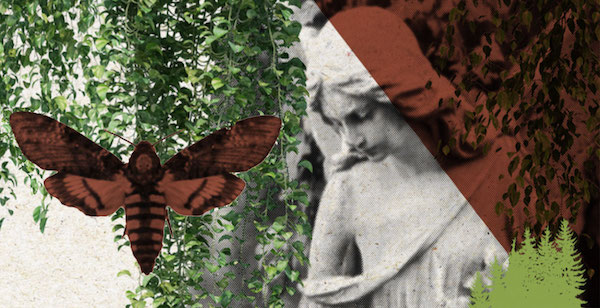How to Die Sustainably
By Katie Conley
The Sustainability of Death
In their 1976 classic, (“Don’t Fear) The Reaper,” Blue Öyster Cult sang that “40,00 men and women” die every day. Today, that number is more like 151,600. That’s a lot of bodies, and frankly, we’re running out of places to store them all. Ignoring sustainability entirely, how we dispose of our deceased is becoming a big problem. In Sweden, for instance, your grave is dug up twenty-five years after burial, your corpse is pushed farther into the ground, and another body is added on top—there simply isn’t space for new bodies. The Swedes are known for their compartmentalization (I see you, IKEA! Loveyour meatballs!) but when it comes to our final resting place, there’s got to be a better way.
Environmental activist Edward Abbey, famously buried in the desert in a sleeping bag, stated that “[After] the moment of death . . . we should get the hell out of the way, with our bodies decently planted in the earth to nourish other forms of life—weeds, flowers, shrubs, trees, which support other forms of life, which support the ongoing human pageant—the lives of our children. That seems good enough to me.” And today, you can do just that. Although cremation remains the number one choice of disposal in North America, and traditional burial a close second, green practices are quickly catching up.
Cremation does indeed create less waste than a traditional casket and land plot, but the “natural gas that goes into a cremation is [equivalent to] two full tanks of an SUV, or a 500-mile car trip,” as mortician, author and “Good Death” advocate Caitlin Moran told Jezebel. Perhaps more disturbing is the amount of mercury released into the atmosphere during cremation due to…brace yourself…our dental fillings. You don’t see a pamphlet about thatat the dentist’s office. Bestselling author Mary Roach notes in Stiff: The Curious Lives of Human Cadaversthat “the average amount of mercury released into the atmosphere” is “three grams per cremation.” Maybe we all should have flossed more?
If you lived your life sustainably, why wouldn’t you die sustainably? We’ve provided an intro to green burials, but this is just the tip of the iceberg. You can be buried on a funeral pyre, thanks to the help of organizations like the Crestone End-of-Life Project; you can donate your body to science, perhaps at The Body Farm, where your decomposition will help forensic scientists solve crimes; or you can go full-on Edward Abbey and decompose back to the earth. (The legality on that last one is iffy, but hey, chase your bliss). We’ve all got to go sometime. Know your options, create a plan with your loved ones and research, research, research. Make your memorialization an eco-conscious testament to the way you lived your life.
What Constitutes a Green Burial?
To be considered “green,” according to Ellen Newman of the Good Green Death Project and TalkDeath, a burial must adhere a few basic standards:
For the Body:
-No embalming fluid.
-Natural shrouds or compostable/recyclable “basket casket” are utilized. Youcanhave a casket, but it must be made from biodegradable materials. Remains (if in powder form) must be in a biodegradable container.
For The Gravesite:
-No grave markers. Naturally occurring markers like trees or stones are fine.
-No vaults or grave liners.
-No non-native species planted on burial grounds; no maintenance for the plants or grounds.
Complete Article ↪HERE↩!


